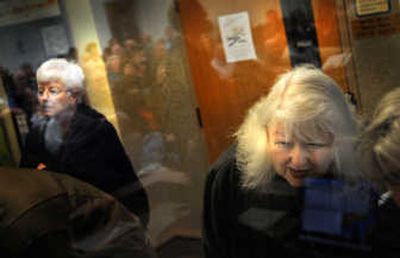Residents: Keep one-ways

A clear message emerged at Thursday’s public hearing on Spokane Valley’s proposed revitalization plan: Don’t mess with Sprague-Appleway traffic.
Except maybe to extend the one-way couplet all the way to Liberty Lake.
Speaker after speaker from an overflow crowd of 130 gave that message to city planning commissioners in more than two hours of testimony.
White-haired Ann M. Ohler got forbidden applause when she said eliminating one-way traffic on Sprague Avenue and Appleway Boulevard would be “asinine.”
“I pay taxes, and I’ve built more schools than you can shake a stick at,” Ohler told commissioners. “We need a sensible group of governing people who see the needs of the people.”
Other concerns that surfaced Thursday were that proposed sign regulations are too restrictive, that a grandfather clause for existing businesses is too weak and that some properties would be “down-zoned” from commercial to residential uses.
Susan Scott said her property value would be reduced 40 to 60 percent, and her business would be placed “on life support with the Planning Department’s hand on the plug.”
“This is Spokane Valley,” Scott said. “People live here because we like it the way it is. It’s conservative, hardworking and practical.”
Bob Nevers said his property value would be “chopped in half.”
“You just can’t do that to small people” whose life savings are at stake, he said.
Randy Grinalds said requiring existing businesses to meet the new code if renovation costs exceed 15 percent of a building’s value probably would backfire by discouraging improvements.
Representatives of two proposed projects – a financial institution and senior housing – complained that zoning changes would freeze out their clients.
Also, the University City Shopping Center’s attorney objected to language that would require the mall owners to build a new road even if plans for turning the mall into a city center fall through.
Overwhelmingly, though, testimony focused on traffic. Even in portions of the meeting reserved for other aspects of the plan, people objected to the proposed restoration of two-way traffic.
Chris Sheppard said eliminating the one-way couplet “would be a total nightmare. It would be like living in Seattle trying to get home.”
“I want to be able to go to the other side of town and not be jammed up like I was before,” Lloyd Benson said. “The only thing wrong with this couplet is it’s not extended.”
Only a handful of speakers endorsed the idea of reducing the number of lanes on Sprague and Appleway and making both of them two-way streets.
Restoration of two-way traffic is intended to help business owners who say the one-way couplet has cost them customers.
However, even some Sprague Avenue business owners didn’t think returning to two-way traffic was a good idea.
“Every business along the couplet finds it convenient to blame the couplet for all their problems, but it isn’t so,” dentist Gene Hinkle said, adding that he found nothing in his property deed giving him the right to “create gridlock.”
Bill Coyle, who owns the Plantland Nursery near Sprague and Sullivan, called for the one-way couplet to be extended all the way to Liberty Lake “to bring people quickly and easily to the new city center.”
Several people praised aspects of the plan to redevelop Sprague Avenue’s long commercial strip, and a few gave unreserved support.
Dentist Philip Rudy stood up for two-way traffic and a monorail. He was among numerous speakers who called for better mass transit, but most – like Angela Wakan – wanted a light rail system.
“I really like the plan,” said Wakan, a young mother who attended the hearing with her children. “As part of the young working class, this is something that would bring our family to Spokane Valley.”
She said she would consider buying a condo in one of the proposed urban mixed-use areas.
“I am concerned that Spokane Valley needs an atmosphere and a city center that we can be proud of,” Sprague Avenue flooring business owner Carolyn Gallion said. “I love this (plan).”
“I think that returning to a two-way street in some places on Sprague would be a very good thing for businesses and for pedestrians,” said Nancy Nishimura, owner of the Green Thumb Nursery.
Nishimura said she found it difficult to cross Sprague’s five lanes of traffic as a pedestrian.
Like Gallion, Nishimura was eager to spiff up Sprague Avenue’s image.
“You’re going to have an experience going down Sprague, but it’s going to be road rage,” Grant Rodkey said.
David Gnotta suggested a compromise in which the one-way couplet would be retained, but with pedestrian islands and perhaps fewer lanes.
Grinalds thought sandwiching a two-way Sprague Avenue between a pair of one-way streets – Appleway Boulevard and, perhaps, Broadway Avenue – might “keep both sides of the aisle happy.”
Barry Losh questioned whether the redevelopment plan is financially feasible, and Fred Hiatt was pretty sure it isn’t.
“It’s gorgeous, it’s beautiful, it’s great,” Hiatt said. “But do I want to lose my business? We don’t have the economic base to support what you’re planning.”
Take “small steps” and “be judicious with our money,” Losh urged.
Focus on developing a city center with a couple of nice restaurants and a rent-free city hall big enough to accommodate a crowd like the one that turned out Tuesday, Ron Roberts urged.
Let the crowd get there on a one-way couplet, he added.